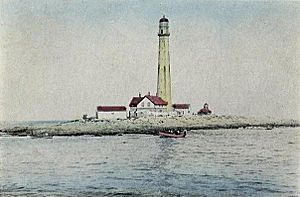Boon Island facts for kids
Boon Island is a small, rocky island in the Gulf of Maine. It's about 6 miles (10 km) off the coast of York, Maine. At low tide, the island is roughly 300 feet (91 m) by 700 feet (213 m).
Boon Island is famous for its tall lighthouse, called Boon Island Light. This lighthouse is 137 feet (42 m) high, making it the tallest in New England. Many ships have crashed on its rocky shores over the years. Even John Winthrop, an important figure in founding the Massachusetts Bay Colony, mentioned passing Boon Island in the 1600s.
Contents
Boon Island Light
The first structure on Boon Island was a wooden day beacon, built in 1799. But it only lasted five years! Strong storms often hit Boon Island. The island's highest point is only 14 feet (4.3 m) above sea level. Huge waves can throw boulders across the island, destroying buildings.
After the wooden beacon, a stone day beacon was built. In 1811, a stone lighthouse was constructed. It stood 32 feet (9.8 m) above the water. It was rebuilt in 1831 to be 49 feet (15 m) tall. But the weather kept causing damage.
So, in 1854–1855, the current Boon Island Light was built. It's 133 feet (40 m) tall and made of large granite blocks. It cost about $25,000 to build. Living on such a lonely island was tough for keepers. Many came and went quickly. But one man, William W. Williams, stayed for 27 years and lived to be over 90!
In 1978, a powerful winter storm hit the island. Two lightkeepers had to hide in the light chamber. The wind and sea destroyed all other buildings on the island. Water even rose five feet up the tower! The keepers were rescued by helicopter the next day. The tower was fixed and now works automatically. It is powered by solar power.
Shipwrecks
Many ships have been wrecked near Boon Island. Here are some of the most famous stories.
Increase (1682)
The coastal trading ship Increase crashed in the summer of 1682. This event is believed to be how the island got its English name. Four people survived: three Europeans and one Native American. They lived on fish and gulls' eggs.
After a month, they built a fire to get attention. They saw smoke from Mount Agamenticus in York, Maine. People on Mount Agamenticus saw their smoke and rescued the castaways. The survivors felt their survival was a special gift from God, a "boon." So, they supposedly named the island Boon Island.
However, Celia Thaxter, a writer from the 1800s, called Boon Island "the forlornest place that can be imagined."
Nottingham Galley (1710)
A more famous shipwreck happened on December 11, 1710. The British merchant ship Nottingham Galley, captained by John Deane, crashed. All fourteen crewmen survived the first crash. Sadly, two later died from their injuries. The remaining ten crewmen stayed alive for twenty-four days in winter. They had no food and no fire until they were finally rescued.
The difficult story of their survival was made into a novel in 1956 by Kenneth Roberts, called Boon Island. It is said that after the Nottingham Galley disaster, local fishermen started leaving barrels of supplies on Boon Island. This was in case other sailors ever got shipwrecked there.
Interestingly, just 8 miles (13 km) southeast of Boon Island are the Isles of Shoals. On Smuttynose Island, there's a small house built in the 1950s. It's open all the time for sailors in trouble. It even has a barrel of supplies for shipwreck survivors.
In 1995, Dr. Warren Riess from the University of Maine led a trip to find items from the Nottingham Galley. His team found some artifacts. You can see these items at the Maine State Museum.
Empire Knight (1944)
In February 1944, a large British cargo ship called the Empire Knight ran aground at Boon Island. It was 428 feet (130 m) long. The ship later broke into two pieces. The back part of the ship, which held its cargo, sank about 260 feet (80 m) deep. This was about one and a half miles (2–3 km) from the island.
In 1990, the United States Coast Guard learned that the ship might have been carrying a lot of mercury. Mercury is a heavy, silvery element. Investigations showed that mercury flasks were on the ship. These flasks had broken open, releasing the mercury. An estimated 16,000 pounds (7¼ metric tons) of mercury are still unrecovered in the ship's cargo hold.
Ownership
In May 2000, the U.S. Coast Guard rented Boon Island Lighthouse to the American Lighthouse Foundation (ALF). This group works to restore and protect historic lighthouses.
In 2014, the lighthouse was sold to a real estate developer named Art Girard. He then sold it again in 2015 to a company called Boon Island LLC.


